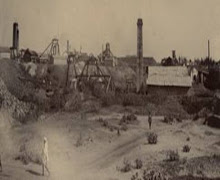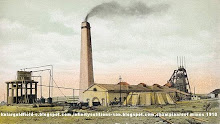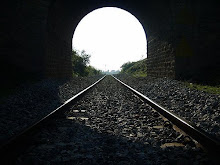With the closure of Bharat Gold Mines Limited now a reality, the livelihood concerns of its 3,800-strong workforce come to the fore.
PARVATHI MENON
in Kolar Gold Fields
AT least 5,000 commuters pack the morning Surana Express train from Kolar Gold Fields (KGF) to Bangalore each day. A majority of them are employees of Bharat Gold Mines Ltd who have been out of work ever since the BGML management declared its closure in April 2000, and stopped paying wages from March 2001. This decision led to the swift descent into poverty of a majority of the 3,800-strong workforce and their families, the overwhelming majority of whom are from Scheduled Caste and Scheduled Tribe backgrounds. The workers, fourth generation miners who operated Asia's largest and deepest gold mine, now travel to Bangalore each day to seek work as construction labourers, head load workers, watchmen, waiters...
S. Ganesh, an underground worker in the Mysore Mines, works as a mason at Rs.80 a day, hardly enough to maintain his family comprising his wife and three children. He has pawned his belongings of value and has accumulated debts of Rs. 30,000.
Workers of Bharat Gold Mines Ltd, and their families, take out a rally in Bangalore demanding alternative jobs.
S. George, a worker for 22 years in the central BGML workshop, has ten family members including seven children between the ages of seven and 19. "I have been working off and on as a security guard, but the wages are even lower than the Rs.2,000 I used to take home as a BGML worker. I am now in debt for Rs.80,000," he said. "Our condition is desperate. We eat two instead of three meals a day and we don't know how we are going to survive," he says.
Many of the workers are deeply in debt. "Even the seth (moneylender) now says he has no money to give us," M. Kavita, an employee's wife said. She and her husband M. Kirubakaran pawned their valuables for Rs.15,000 and have accumulated loans amounting to Rs.20,000. They have taken to selling vegetables from their house. "We are lucky if we make ten or fifteen rupees a day from this," Kavita said.
Even though the Karnataka High Courthas not taken a final decision on the company's fate, there is a deep and perceptible sense of despondency and loss of hope amongst the workforce, reflected in the talk of mounting debts, starvation, death and suicide. "Several workers have died since the closure, owing to ill-health and lack of medical care, and in a few cases they have committed suicide," S. Shekharan, a miner for 23 years, said. "My family survives thanks to my brothers and sisters in Bangalore who help us." This correspondent went to the home of P. Pushparaj, a worker who hanged himself two months ago. The small hut was locked as his wife and daughter were away in Bangalore for the day. Neighbours said that Pushparaj left a suicide note in which he stated that the company's closure, which led to his personal difficulties, was the reason for his taking the drastic step.
Francis Kumar, 40, a worker who had three young children, developed high fever one evening. Rushed to hospital, he died the next morning. Francis' health had deteriorated since the closure, his family members said. He used to work late hours as a restaurant waiter, and was deeply worried about the future and what it held for the children. His family is being helped by kindly, and relatively better off, neighbours.
"So much publicity has been given to the suicides of farmers in different parts of the State," K. Rajendran, general secretary of the Janata Dal (S) labour cell, said. "There have been at least 40 deaths since the closure of the mines, all of which I believe were directly or indirectly linked to the closure."
THE entire KGF township with its population of three lakhs, and not just the employees, depended on BGML for survival. The death of the mines is choking its economy. The once humming township, set in picturesque, undulating countryside and given the name of 'Little England', is today silent and listless. Its residents find it hard to refashion their lives to a harsh new reality. The closure has affected every aspect of life and even the physical environment of the township. The shops and commercial establishments depended on a workforce with purchasing power. The local job market has shrunk, and even small manufacturing units, once dependent on the BGML, have closed down.
The worst affected, however, are the residential areas where over 70,000 persons - workers, ex-workers, and their families - live in small asbestos sheet-roofed homes. The company has withdrawn electricity, water and sanitation services. Many homes have had their electricity connections cut as workers can no longer afford to pay their bills. It is a common sight to see waiting queues of women with their plastic pots near the few water pumps in the miners' quarters. Sanitation services have been all but withdrawn from the colonies, and the stench of clogged sewage drains, and piles of uncleared garbage and refuse, permeates the living space. During the course of the year-long closure battle in the High Court, the BGML management handed over the sanitation and water supply functions to the Robertsonpet City Municipality and agreed to provide an assistance of Rs.50 lakhs. But sanitation and garbage disposal work have been almost stopped now, allege the residents of the colonies.
Yet another aspect of the situation that has caused anguish to BGML families is the matter of their children's education. The KGF township has several schools, both government and privately run. Workers now find it difficult to afford the fees, and the cost of books and stationery. Several employees said that schools did not release their children's results this year as fees had not been paid. M.P. Arogyadas, a teacher of Tamil in the St. Mary's Boys Higher Primary School, said that the pupil strength of the school had fallen and was only 250 now. Many parents are pulling children out of school as they cannot afford the fees and are sending them to work in shops, restaurants and automobile repair sheds. "Two of my sixth standard students, Prabhu and Karthik, are today working in a shop," he said. With their own lives a shambles, workers hoped that their children, armed with an education they themselves did not get, would build new lives. That dream is being shattered
"The situation of the workers is desperate and the township itself is threatened," said K. Rajendran. "Employees are now taking up all kinds of low paying jobs - construction work, painting, bar bending, loading and unloading. Some are even engaged in the cutting and selling of wood. Why are successive governments neglecting the plight of KGF?"
In its history of over two centuries, the Kolar Gold Mines has changed ownership several times. The mines were handed over to the Central government by the Mysore government in 1972 and became a public sector undertaking. By 1992, accumulated losses were over Rs.502 crores and it went before the Board of Industrial and Financial Reconstruction (BIFR). While successive managements have presented the company's losses as being the result of the terminal depletion of high grade ore and the consequent increase in the cost of production, the unions and some industry analysts have taken a different point of view. According to them, the primary reason for the losses was the government's gold pricing policy. Till 1988, the Government of India, the sole purchaser of gold from BGML, was paying for it at the London Metal Exchange rate, which was just 10 per cent of the cost of gold in India. The difference in the price, which should have been given to the company as a subsidy, was instead given as a loan on interest. This put an enormous and unfair burden on the company.
A closed mine shaft at Kolar Gold Fields.
The BIFR appointed the Industrial Credit and Investment Corporation of India (now ICICI Ltd) as the company's operating agency. In July 1997, ICICI recommended a rehabilitation package which envisaged an infusion of fresh capital of Rs.200 crores, an option that the Central government rejected. Several proposals for the running of the mines were made to the government, the BIFR and the Appellate Authority of Financial and Industrial Reconstruction (AAFIR). The unions put their own revival package before the BIFR in January 2000. This envisaged the company being given access to a revolving fund of Rs.10 crores from a financial institution. Under this scheme, bank credit was to have been on the hypothecation of stocks of raw material, semi-finished goods and bills.
The scheme anticipated that the company would break even in the third quarter of a two-year period.
Apart from schemes for conventional mining, a scheme was put up for surface mining. In July 2000, the Bharat Gold Mines Employees Union (BGMEU) put up a proposal before the AAFIR for extracting gold from the tailings. The tailings - the waste soil which over the years has formed long stretches of steep ridges, changing the landscape of the region - contain deposits of trace gold. "There is a gold mine above the mines," said V.J.K. Nair, president of the BGMEU. "Technical survey reports and government instituted surveys say that the 34 million tonnes of tailings contain 0.75 grammes of gold per tonne. This has a value of Rs.12,000 crores and can be processed for the next 16 to 18 years." The average realisation of gold per tonne when the mines were in operation was 2 gm, which has gone up to a maximum of 5 gm in some years. This scheme required an investment of around Rs.60 crores and, according to Nair, would have generated a profit of Rs.90 crores once the project was fully implemented. Nair said: "The AAFIR heard us out and actually gave a stay on the BIFR proceedings for a period of 45 days asking us to find the money. The government at that time had offered a voluntary retirement scheme (VRS) of Rs.80 crores. Why could not they have used that to find ways of keeping the mines open?"
On April 16, 2001, the High Court quashed the closure order issued by the Ministry of Labour under Section 25(O) of the Industrial Disputes Act, 1947. The winding-up order issued by the BIFR was also quashed by the court and it directed the BIFR to consider revival proposals. Operations had closed from April 2000, although idle wages were still being paid. The government and the company went in appeal to a Division Bench of the court and got a stay on the order of the single bench. "Although the court only issued a stay, the company proceeded on the assumption that the closure order was revived," said R.N. Godbole, general secretary of the Professional Workers Trade Union Centre of India (PWTUC). "They began to sell assets, like machinery, and in March this year, stopped paying wages." The Karnataka Electricity Board stopped power supply to the mines as the BGML was in arrears and was unable to pay its dues. With no power to pump water out, the centuries-old mines have now got flooded. "This is really a criminal act in which none will be held accountable," said Godbole. "The mines have been made inoperable, even for use at a future date. Lifts and machinery left in the shafts would have become totally unserviceable."
Although the unions are holding on to their demand that the mines be reopened, in practical terms it is a fair VRS package that they are now fighting for. In December 2000, the management offered a VRS that involved the payment of 45 days' salary for every year of service. Since there had been no major pay revision in BGML since 1987, the compensation the workers would have got would have been poor. The unions rejected this package. In November 2001, the government announced a Modified Voluntary Retirement Scheme (MVRS) in respect of companies which were running at that date, in which twice the compensation would be paid. Although the BGML unions have demanded the implementation of the MVRS, the government has refused it on the ground that the BGML was closed well before November 2001. This stand is questionable as the issue of final closure still awaits a court decision.
With the closure of the mines now a reality, citizen's groups like the BGML Revival Coordination Committee have tried to broad-base the "Save KGF" campaign. One of their demands to the Central and State governments is to make KGF, with its infrastructure, connectivity to Bangalore, good climate, and ready workforce, an investment destination, particularly for the software industry. This could provide the much-needed oxygen for KGF and its residents to survive.
Volume 19 - Issue 11, May 25 - June 07, 2002India's National Magazinefrom the publishers of THE HINDU
THE STATES
By
sannthosh
A Free Numerology
Saturday, 6 September 2008
Subscribe to:
Post Comments (Atom)





















No comments:
Post a Comment